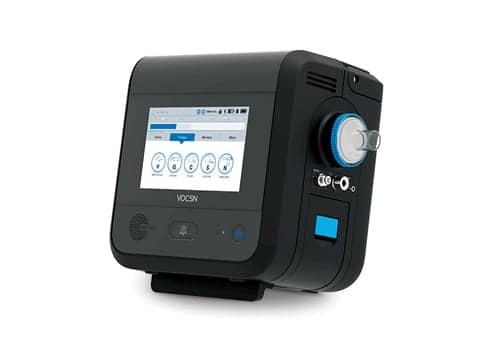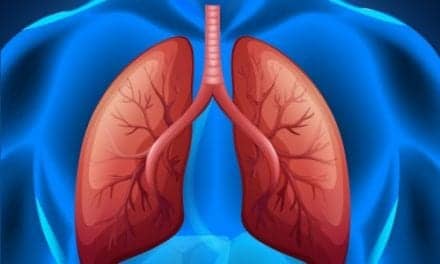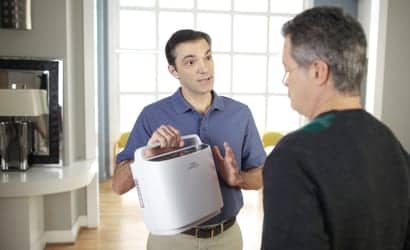Clearing airway secretions has benefits not only for airway function but also infection prevention. One such therapy for clearing the airways of patients is cough assist.
The reflex to cough is so automatic for most people that it is often taken for granted, but those with muscle weakness or paralysis may not have the strength to perform this basic function. When their airway muscles become weak, it can be hard or even impossible to cough. Secretions pool in the airways, respiratory infections develop, and breathing becomes strained. This is when healthcare providers can turn to mechanical assist cough machines, devices that simulate a cough.
“It basically vacuums the airways free of secretions. It’s extremely effective and is much more comfortable than the other ways of clearing mucus, which can involve placing catheters into the airways” said pulmonary critical care physician Joshua Benditt, MD, professor of medicine at the University of Washington Medical Center in Seattle. “Mechanical cough therapy is preferred if at all possible.”
Insufflation-Exsufflation
These machines, also known as mechanical insufflator-exsufflators (MI-E), typically alternate between inflating the patient’s lungs and then suctioning up mucus that would otherwise be stuck in the airways.1 There are a number of MI-Es on the market and they are relatively easy to use, effective at avoiding unplanned hospitalizations and can help prevent the need for tracheostomy and long-term ventilation in patients with weakness in the muscles or nerves. This can include patients with spinal cord injuries, muscular dystrophy, ALS, or other conditions that may lead to weakness. It is generally not used for patients with COPD, cystic fibrosis or others who might not have an impaired cough, said Benditt.
Overall, mechanical cough assist can greatly improve patients’ quality of life while keeping them healthy. “The patients themselves, once they get used to the feeling, often will request this and will know when they need to use this and will signal to the caregiver when they need to use it,” said pediatric pulmonologist Bruce K. Rubin, MEngr, MD, MBA, FRCPC.
In the Journals
Research published in the peer-reviewed journal Respiratory Care in 2017 shows that these devices are more effective than respiratory physiotherapy alone for critically ill patients on ventilators in the intensive care unit (ICU).2 This study found that the combination of physiotherapy and mechanical cough assist resulted in airways that were twice as clear compared to patients who only received physiotherapy.
The study’s authors wrote that the use of MI-E had the potential to decrease the risk of ventilator-associated pneumonia and shorten stays in the intensive care unit for this patient population.
Mechanical cough assist machines are generally only used for people who have neuromuscular problems, but there is research that shows that patients in the ICU who are very weak may also benefit from this therapy, said Benditt.
On the Market
Mechanical cough assist has gone through several iterations since the early 20th century. Some of the first versions came out during the polio epidemic. In the last several years, Philips Respironics has become a leader in the industry, producing the CoughAssist T70, a portable, compact device that weighs less than 9 lbs. The CoughAssist T70 clears secretions from the lungs by gradually applying positive air pressure to the airway and then rapidly shifting to negative air pressure, a process that simulates a deep, natural cough.
A proprietary algorithm called the Cough-Trak gives patients more control of their therapy. “Cough-Trak allows patients to initiate therapy through inhalation and determine the length of the therapy pause times helping both comfort and compliance,” said Lauren Barkauskas, senior global product manager for airway clearance and secretion management at Philips.
The machine offers an adjustable oscillation to loosen mucus from the bronchial walls and improve bronchial drainage, says Barkauskas. There are several, adjustable, automatic and manual settings. The CoughAssist T70 also can give patients pre-therapy breaths, designed to improve patient tolerance by providing a “warm-up” period prior to the initiation of the MI-E treatment, similar to stretching prior to a workout, said Barkauskas.
More recently, the medical manufacturer Ventec Life Systems released the VOCSN, a portable life support device that combines five respiratory therapies: ventilation, oxygen, cough, suction, and nebulization. Last year, this device received approval from the US Food and Drug Administration and is now covered by Medicare.
According to Ventec Life Systems, caregivers can seamlessly switch between therapies with the touch of a button and no longer need to change the patient circuit between therapies. “I have one patient who uses it now with spinal cord injury and she absolutely loves it,” said Benditt.
The small size makes it especially convenient, added Benditt, who is on the medical advisory board for VOCSN. “If I had a patient who had each one of the five devices that they have in VOCSN, you would need a cart to carry them,” he said.
Use Appropriately
Aside from staying informed of new cough assist devices, providers should make sure that they’re using the machines correctly. Respiratory therapists will sometimes push saline into a patient’s airways in a misguided attempt to loosen secretions in combination with using mechanical cough assist, said Rubin, pulmonology professor at Virginia Commonwealth University School of Medicine.
This can drive secretions deeper into the airway and make them harder to bring up, creating more discomfort for the patient, said Rubin, a trustee for The American Respiratory Care Foundation.
He said that the most important step is to ensure that patients are comfortable while the machine is working. If administering the therapy to a new patient, start the pressure on a low setting and then slowly dial it up if secretions are not being removed adequately.
After applying mechanical cough assist, there may be mucus left in the patient’s mouth. Respiratory therapists should make sure to finish the job by suctioning out these remaining secretions with a small catheter. This process, for patients who are extremely weak, is typically performed as many as four times per day, but it can be used as frequently as once an hour. “Patients will do it when they feel they need it,” said Rubin. “It’s very safe and when it is effective, the patients appreciate it.” He recommends that before using the machine on a patient for the first time, providers should take the time to thoroughly explain what the device is and how it feels when the machine is in use.
Rubin suggested that new respiratory therapists test the mechanical cough assist devices out on themselves, so they can better communicate what the experience will be like to their patients. This will also allow therapists to get a better sense of how the pressure feels on different settings since some new respiratory therapists might be hesitant to set the device on a higher pressure.
“Try them on, see what it feels like. Understand that they are not harmful, they are not damaging,” said Rubin. “It will give you a better idea of what the machine is capable of doing and what you are able to teach the patients.” RT
Lisa Spear is associate editor of RT Magazine. For more information, contact [email protected].
References
1. Mechanical insufflation-exsufflation: Practice patterns among respiratory therapists in Ontario. https://www.ncbi.nlm.nih.gov/pmc/articles/PMC4467476/
2. Effects of Mechanical Insufflation-Exsufflation on Airway Mucus Clearance Among Mechanically Ventilated ICU Subjects. http://rc.rcjournal.com/content/63/12/1471











Many cough assist devices are used incorrectly. It is important to inflate the lungs more slowly than deflating them. I see too many machines set for an I:E of 1:1. Mucus is pushed dismally on the inspiration phase…
Also, it is critical to give the weak patient a full inflation at the end of each cycle; otherwise, the patient develops atelectasis…
How long should the therapy take ? Are there aside effect if the therapy takes longer than an hour?